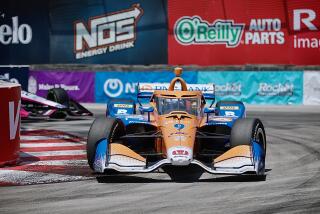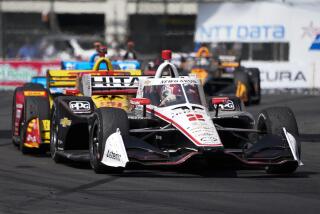Fittipaldi Eyes Title : Brazilian to Open His Indy-Car Bid at Long Beach
Mario Andretti won three U.S. driving championships before moving to the world Grand Prix circuit and winning the Formula One title.
Emerson Fittipaldi of Brazil would like to reverse that process. He has won two world championships and this year plans to race full-time for the CART Indy car crown.
“I am fortunate to be driving with one of the strongest teams for my first full season in Indy car racing,” said Fittipaldi, who drove in nine races last year for several teams.
Fittipaldi, 38, will be in a new Cosworth-powered March 85C, owned and prepared by the Pat Patrick racing team. He will have two teammates. In road races, starting with the season opener April 14--the Toyota Grand Prix of Long Beach--it will be Bruno Giacomelli of Italy. On the ovals, it will be two-time Indianapolis 500 winner Gordon Johncock of Coldwater, Mich.
“The ovals are a new challenge for me, something new to conquer, but if the Indy car series were just ovals, I would not be contesting for the championship,” said Fittipaldi, who drove the first oval race of his career last year at Phoenix.
“Perhaps I would race Indianapolis, because it is so important, but that would be all. Now, with half the series on road courses, I am anxious for the season to start. Johncock has taught me a lot about oval racing and will help me set up my car for Indianapolis.
“There is a great deal more interest in Indy cars in Europe since the series became half oval and half road. It has created a new category in international racing and because of that I think motor racing owes Chris Pook (founder of the Long Beach Grand Prix) a great deal.”
Pook, a former travel agent who wanted to draw attention to Long Beach as the International City, conceived and produced the first modern street race in America in September of 1975, when he held a Formula 5000 race along Ocean Boulevard as a prelude to an annual series of Formula One races. After eight years with Grand Prix cars, Pook switched to Indy cars for his seaside circuit race last year.
“I remember in 1974 or ’75 when Mario (Andretti) told us we were going to run a Grand Prix in California on the streets,” said Fittipaldi. “We (Formula One drivers) told him there was no way we would run, that it wouldn’t be safe with concrete barriers for fences. But Pook made believers of us and now street courses with concrete blocks are among the safest in Grand Prix or Indy car racing.
“Pook made it possible to take races to the people, to downtown streets in big cities, and that has opened new marketing areas and created more racing venues in crowded areas. Before Long Beach, there were no races in cities like New York (the New Jersey Meadowlands), Detroit, Dallas, Cleveland, Montreal, Las Vegas or Miami. Today, cities all over the world are considering street races. Pook deserves a great deal of credit for making it happen.”
The Long Beach race is on a 1.67-mile circuit that winds through the Hyatt Regency Hotel garage, around the Convention Center and Sports Arena complex and alongside Shoreline Village.
Fittipaldi, who won the world championship with Lotus in 1972 and with McLaren in 1974, abruptly retired from Formula One racing at the conclusion of the 1980 season.
“The Grand Prix car, with its full ground effects, had become too dangerous to drive,” he said. “I could not accept the risk. The sport of motor racing has risks which you must accept, but there is a limit. If you notice, I was not the only one to get out of Grand Prix racing about that time. Niki Lauda, Jody Scheckter, James Hunt, Alan Jones and Mario all retired or left Formula One. Lauda came back, but not until the rules were changed.
“It was as simple as this: When I leave home, carrying my helmet with me, if it goes through my mind that something bad might happen to me, I had better stay home and watch TV. You cannot sit in the cockpit of a racing car and think that way. I was fighting myself mentally, so I quit.”
A Brazilian sports hero second only to soccer’s Pele in popularity, Fittipaldi ended his retirement last year after making what he called a test run in the Miami Grand Prix, a sports car race along Biscayne Bay in a setting similar to Long Beach.
“Ralph Sanchez (director of the Miami Grand Prix) called me in Brazil at the end of 1983 and said he wanted me to drive his Porsche in Miami in February. I agreed to come because I was curious to know how I would feel driving a race car again.
“I had raced 135cc Super Karts in Brazil that year, so I felt I was sharp, but I didn’t know what it would be like in a full-fledged racing car. I felt I had to try again. When I got to Miami, I felt comfortable, even though I was not used to the heavier IMSA car.”
Fittipaldi, despite being away from international competition for three years, was the fastest qualifier at Miami, but in the race his engine gave out 18 laps from the finish.
“I found out how much I missed racing, and I showed I was still quick. I was ready to race fulltime, but by then all the Formula One teams were signed up.
“Two teams called but they were not competitive and I did not want to be just another number in the race. I wanted a strong car, but the timing was bad. I would have gone back to Brazil rather than take a bad ride.
“I also had calls to drive for other IMSA teams and then when Pepe Romero asked me to drive his Indy car, I decided to do it.”
Long Beach was his first race and Fittipaldi finished fifth after running as high as second behind Andretti, who led all the way. At Indianapolis, after qualifying 23rd, Romero’s March lasted only 39 laps before dropping out with an oil leak.
“For a small team, Pepe’s crew did a good job,” said Fittipaldi. “The car was set up well and if it hadn’t been for that stupid crack in the oil line, we might have done rather well. The worst thing about Indy was wearing that pink uniform. I was very embarrassed when I saw my friends. I am glad no one in Brazil saw me wearing pink.”
All of Romero’s cars were painted pink and he insisted that his drivers wear pink driving uniforms.
Romero’s team broke up after Indy and when Patrick team driver Chip Ganassi was seriously injured at Michigan, Fittipaldi took over his ride and later signed for the entire ’85 season.
“After free-lancing last year, I realized if I wanted to stay in Indy racing, I needed a team to provide me with testing and good equipment,” he said. “I like testing and it is most important if you wish to be successful. Already this year we have done a lot of testing, more than 3,000 miles.
“We have been to Phoenix, Laguna Seca, Riverside, Hallett, Okla., and Jim Hall’s Rattlesnake track in Midland, Tex. I think we have the most mileage in testing of any team.”
Although Fittipaldi drove a Chevy-powered March for Sanchez again last February in the Miami IMSA race, he plans no other racing except the Indy car series for the remainder of the season.
“I am pleased to do all my racing in America, and to do my best I must concentrate on only one thing,” he said. “There is much more competition here than Europeans realize. For years, the only drivers we heard about were the old generation of oval race drivers like Foyt, Johncock, Rutherford and the Unsers. Except, of course, Andretti, whom we knew.
“Now, there are young lions like Michael Andretti and Al Unser Jr. who could go to Europe and drive in any Grand Prix in the world and be competitive. I think today a driver can learn more coming up here than in Europe. A few years ago it wasn’t that way.”
Fittipaldi and his wife, Teresa, maintain homes in Sao Paulo, Brazil, and Miami.
“I would like to live in California because there is so much more going on here, but I have my home in Miami because it comes down to hours in the air. It is eight hours from Brazil to Miami, and it is 14 hours from Brazil to Los Angeles. That can make a big difference when you make 22 round trips from Sao Paulo, as I did last year.”
More to Read
Go beyond the scoreboard
Get the latest on L.A.'s teams in the daily Sports Report newsletter.
You may occasionally receive promotional content from the Los Angeles Times.










